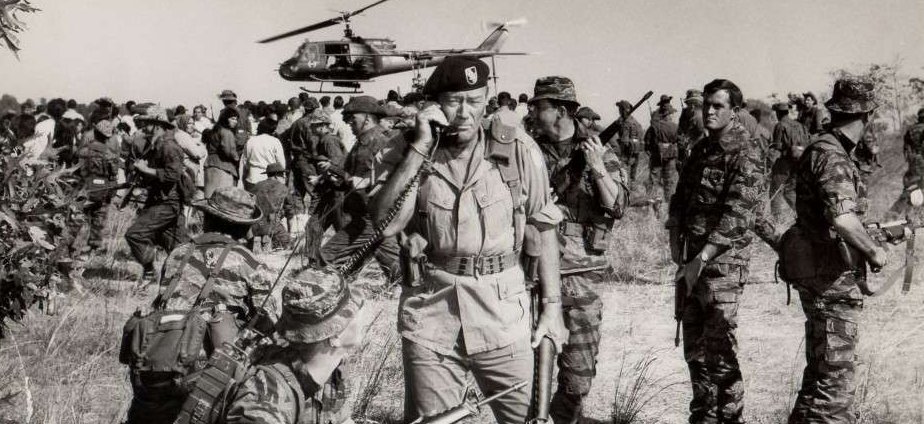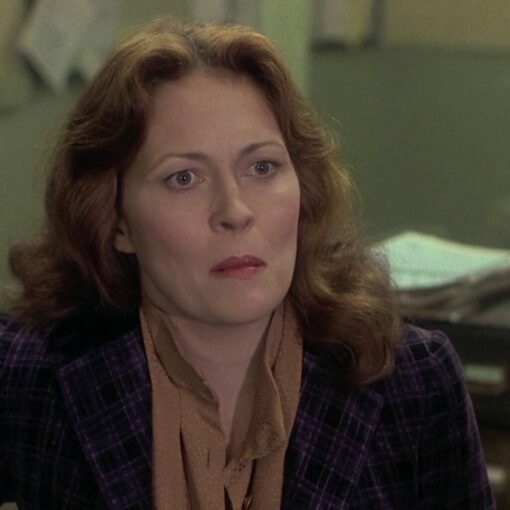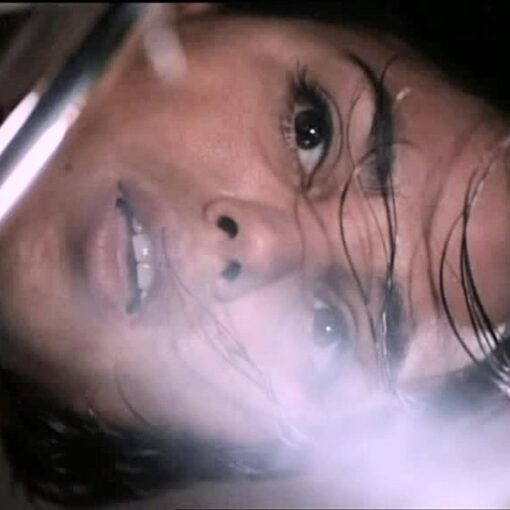The Green Berets, one of the most infamous movies of all time, was butchered by virtually every film critic when it was released in 1968. For those who might not know: it’s an American war movie about the Vietnam conflict, taking a pro-involvement stance. For the occasion, its star and (co-)director John Wayne left his beloved West and went way out East. He wanted to make the home front clear how important America’s presence in south-east Asia was. Instead of scornful and self-loathing – qualities we have come to identify with movies about the Vietnam war – it is self-righteous and idealistic . It’s probably best known for the final scene, with the sun setting in the east.
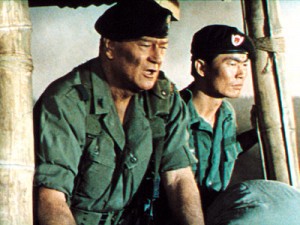
The film is loosely based on the eponymous collection of short stories by Robin Moore. Wayne had bought the rights in 1965, after a trip to Vietnam ‘to cheer up the troops’. He was infuriated by the growing anti-involvement atmosphere in his own country, and wanted to turn the tide with a positive movie about the Special Forces and the fight against communism. One of the problems, so his biographer Gary Wills has pointed out, was that the book didn’t fit his plans at all. It portrays the Green Berets as lawless, sadistic and racist. It took John and his son Michael (who produced the movie) three years to come up with a script that was approved by The Pentagon, who were supposed to back the project (and eventually did). Those three years were fatal for the movie and its star.
One of the storylines is about a journalist, critical of the war, who joins the troops in Vietnam. He eventually becomes a loyal supporter of America’s engagement in the war. This story element reversed the actual experiences of journalists who had made the trip. Most of them had departed with the idea the war was worthwhile and winnable, most of them came back with the opposite idea. And then, in 1968, when the film was finally completed, its release coincided with the alarming reports about the Tet offensive, a turning point for many still believing in this South-East Asia campaign. Even conservative journalists who had been in Nam described the film as ridiculous, all but realistic, and critics did the rest. Still it did pretty well at the box-office. According to John Wayne this proved that those critics had failed to make their point.
How does this infamous movie look today, more than forty years later? America is still fighting wars overseas, but the political context in which the Vietnam War was fought (and this film was made), the Cold War, is history. Some recent comments have been more positive, or at least less patronizing (check for instance the short review on Allrovi). As an action movie it is not bad. There’s a protracted, large-scale action sequence about half-way into the movie, recreating the real-life battle of Nam Don (June 6, 1964) in quite spectacular fashion. There are also few other exciting moments, such as the kidnapping of a Vietcong officer, but at a length of 140 minutes the film feels dreadfully overlong. Not much happens in the first hour and characterizations are clichéd and in one case rather embarrassing. Jim Hutton plays a would-be comical sergeant, a reformed hippy, who becomes the ‘foster father’ of an orphaned Vietnamese boy. Some hints at his character being homosexual, give his role a very questionable ambiguity (apparently not noticed by the film makers). It also leads to the legendary goofy ending with the sun setting in the China Sea. Hutton’s character is killed and commander Wayne has the unpleasant task to bring the sad news to the boy, orphaned for the second time. “I’ll take care of you,” he says, walking with the boy into the sunset, “Coz’ that’s what were here for.”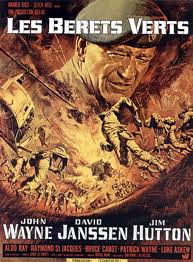
It’s often said that the bravado that had worked well in WWII movies inevitably crash-landed in the context of the Vietnamese conflict. This is not untrue, but The Green Berets is not simply a Longest Day Out East, and John Wayne was well aware of the fact that the situation was completely different. The Nazis had been the baddies in everyone’s eyes and America had sent its best boys to Europe to save the world from the evil incarnate. Wayne now was confronted with the idea that a growing number of people saw the Vietnamese war as a local conflict. Like heavyweight champion Muhammad Ali, who had lost his title because had refused to fight in this war, had said: “I have no conflict with the Viet Cong.” For this reason Wayne, and the Pentagon, wanted to depict the Special Forces as social workers, who were ‘there’ to help orphaned kids and helpless citizens. There are many scenes with the Green Berets accompanying locals who have survived a Viet Cong raid on their village, protecting them against further brutalities of the enemy. In the book the Green Berets had been described as cruel adventurers with a lack of principles, so a lot of changes were made. Unfortunately some of them made things even worse. The best example is the way an infamous torture scene (a Vietnamese officer torturing a Viet Cong POW) is treated. In the book the scene is so gross that it sends shivers along my spine when I think about it (and I read the book more than 20 years ago!). In the movie this torture takes place off-screen, and instead of watching and almost relishing it, the Americans leave the room and say they don’t want to know what’s going on inside. The implication is that Americans are too noble and high-minded for things Asian people do among themselves.
Don’t get me wrong, John Wayne had the full right to give his vision on the conflict. If people are free to criticize their own government and military, others have the right to defend them. It’s more the way it was done that makes this movie, even more than forty years later, a bit painful too watch. If the critics failed to make their point, so did John Wayne. But, as said, as an action movie it works quite well, and if you manage to overlook the clichéd characterizations, most actors do their job quite well. David ‘the fugitive’ Jansen is almost believable as the journalist (and with his laidback acting style he’s the right actor to play alongside Wayne) and Aldo Ray is even a pleasure to watch as a tough but good-natured sergeant. The most surprising name is that of Luke Askew, a cult figure (he would appear in Easy Rider the next year) and one of the first actors daring to wear long hair in Hollywood: he plays a character called Provo, named after the Dutch counterculture movement from the mid-sixties. He dies of course miserably.
References:
Gary Wills, John Wayne’s America, New York, 1997
http://www.allrovi.com/movies/movie/v20871

